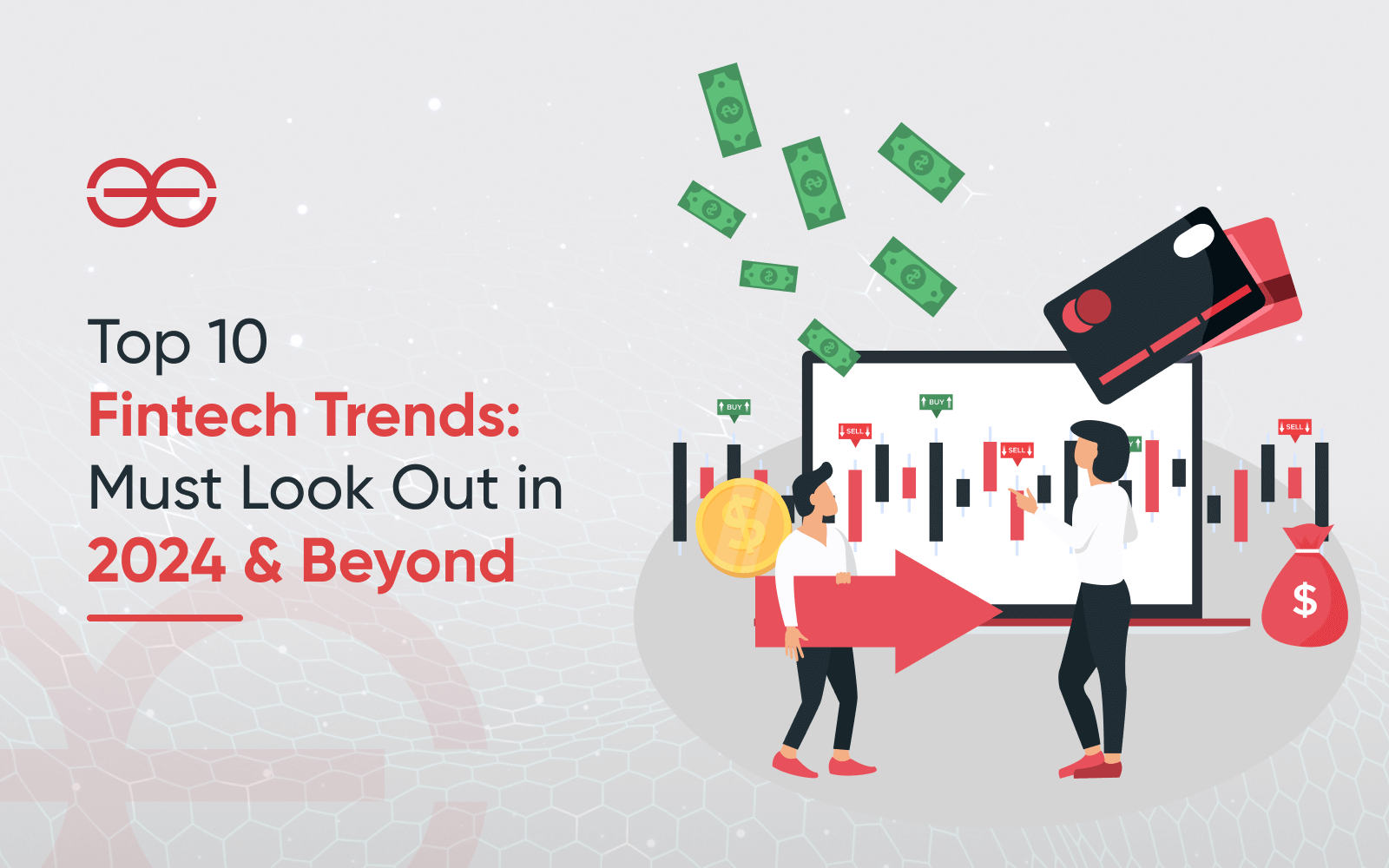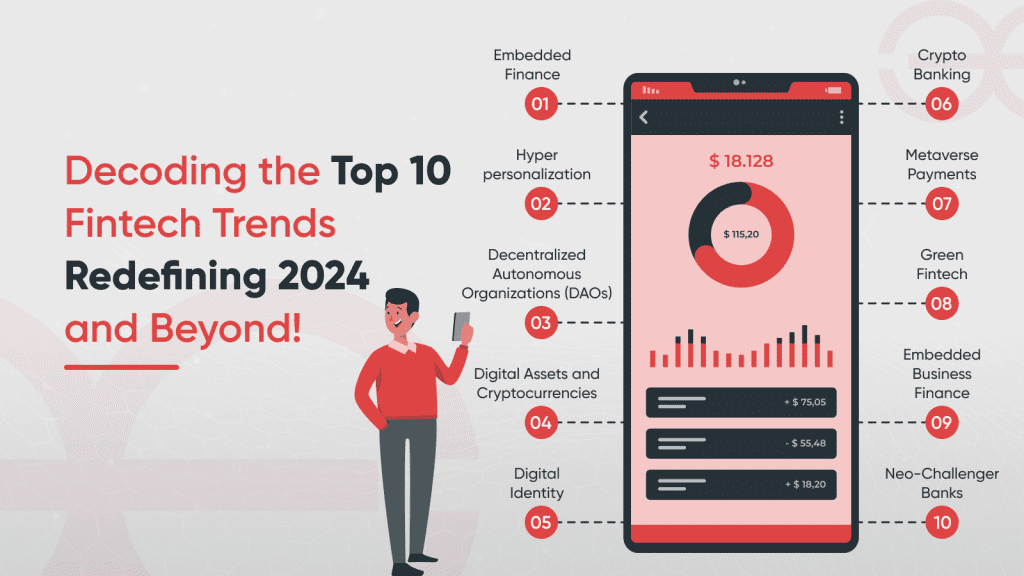The fintech sector has exploded in recent years and shows no signs of slowing down. As we head into 2024, some new fintech trends are taking over the promise of totally transforming the way we manage money. From digital banking to decentralized finance (DeFi), these top 10 fintech trends for 2024 will surely redefine financial services.
First up… embedded finance is totally blowing up, allowing non-financial brands to offer financial services through APIs. Better yet, we will see “buy now, pay later” options everywhere, making it easier to pay for stuff over time. At the same time, open banking and APIs will continue breaking down data silos while enabling more seamless financial experiences.
With a growing adoption of digital assets and cryptocurrency, the role of blockchain technology will expand across fintech. The use of AI, ML, and big data analytics will drive more automated, personalized services.
Spot on! This revolution is not going to stop anytime soon.
But to help you stay ahead, we have gathered some worth-reading information. So, if you want to learn about the top 10 next-gen fintech applications trends that will take 2024 and beyond by storm, this blog post is purely for you.
Table of Contents
ToggleDecoding the Top 10 Fintech Trends Redefining 2024 and Beyond!

-
Embedded Finance
Well, this stands out as one of the finest fintech trends so far…
Financial services will become seamlessly integrated into non-financial environments with the help of APIs and partnerships. For example, e-commerce platforms like Shopify are increasingly partnering with financial institutions and fintech providers to offer embedded financing options for their merchants and customers.
Ultimately, this will make financing frictionless by allowing customers to get loans, make installment payments, etc. directly within the checkout flow. By tapping into provider APIs, companies can embed financial products tailored to their customers without having to build everything from scratch.
Remember, this embedded finance ecosystem is expected to grow rapidly, with nonbanks collectively gaining a big share of the banking market in the coming years.
-
Hyper personalization
This will knock you out…
Artificial intelligence, machine learning, and big data analytics will bring an unmatched level of personal touch to financial services. Instead of a one-size-fits-all approach, the offerings will be tailored based on unique financial profiles, behaviors, life events, and circumstances.
For example, neobanks like Upwise use insights from customer transactions to provide personalized tips for budgeting, saving, and reducing fees. Investment apps like Wealthfront create customized portfolios aligned to a customer’s risk tolerance. In insurance, carriers like Lemonade are using AI to price policies and process claims in a more individualized way.
However, this hyper personalization trend is being driven by the development of AI/ML capabilities combined with the rise of nontraditional data sources. It has the potential to make financial recommendations and products more relevant.
-
Decentralized Autonomous Organizations (DAOs)
Yet another remarkable addition to the array of fintech trends…
Decentralized Autonomous Organizations (DAOs) are set to emerge as a new business model on the blockchain. They are collaborative, community-governed entities with no centralized leadership. In a DAO, participants vote openly on decisions using rules written on the blockchain. All changes must be collectively approved.
DAOs can pool community capital which is programmatically managed according to member votes. MakerDAO is a prime example, using decentralized votes to manage the stablecoin DAI. As blockchain becomes more popular, we might witness new and creative DAO structures emerging to fund and govern various things.
-
Digital Assets and Cryptocurrencies
The adoption of digital assets like cryptocurrencies, stablecoins, and NFTs (non-fungible tokens) is expected to gain significant mainstream influence in the year 2024. In addition, crypto banking services such as lending, borrowing, payments, and custodial accounts will multiply.
Despite its ups and downs, the crypto market is growing up while attracting institutional investments and regulated products. This shift is pulling in more everyday users who want to use digital assets for payments, investments, and unique purposes like NFTs for digital collectibles and identity.
-
Digital Identity
Digital identity will be one of the key emerging fintech trends. Secure digital ID systems with biometrics will enable remote identity verification and financial inclusion at scale. Besides, India’s national biometric digital ID program Aadhaar has already shown potential; Aadhaar has allowed easy electronic know-your-customer (eKYC) processes that previously required in-person verification.
Amazing… no?
Countries worldwide are looking into creating national digital ID systems. These digital IDs will not only make it easier to open accounts but also help prevent identity fraud, meeting important regulations. By using tech like biometrics, blockchain, and AI/ML, digital identity platforms are set to simplify rules and make financial services more accessible.
-
Crypto Banking
You know it, crypto banking is among the incredible emerging fintech trends for 2024 – where cryptocurrency companies aim to become one-stop shops for digital asset financial services. Crypto banks will increasingly resemble traditional banks by offering not just wallet accounts but also savings accounts with interest, crypto-backed lending, debit/credit cards to spend crypto holdings, and investment products like crypto ETFs.
Some key players in this trend are companies like BlockFi, Celsius Network, and Nexo. They provide interest-earning crypto accounts and crypto-collateralized loans. As the crypto world grows, we’ll see crypto banks teaming up with regular banks to make it easy to switch between regular money and crypto.
-
Metaverse Payments
Indeed, the upcoming fintech trends are set to reshape the financial landscape and amaze you with their transformative power … The introduction of VR-based metaverse environments will necessitate new financial systems that allow seamless payments, transactions, and wealth management in digital worlds.
Digital wallets like Meta Pay have already emerged to enable crypto purchases in Meta’s metaverse. But as the interactive metaverses evolve into full-fledged virtual economies, we will see a growing range of financial offerings customized for the platforms including mortgages, lending to investments, insurance, and decentralized finance.
Just like in the real world, people in virtual worlds need ways to buy stuff, do banking, and even handle real estate. Early metaverse money stuff is mixing regular finance, digital money, and cool Web3 wallets. Even though the metaverse is just starting, buying things in virtual worlds is becoming a cool new trend that might one day make the difference between money in the real and virtual worlds hard to see!
-
Green Fintech
Green fintech is a financial technology that focuses on driving sustainability while fighting climate change. In the near future, more startups will use green fintech to support eco-friendly initiatives. There would be platforms for tracking carbon footprints, offering loans for energy-efficient upgrades, analyzing ESG (environmental, social, governance) data for investors, and providing sustainability-linked banking products.
Companies like CoPeople enable individuals to invest in community renewable energy projects. As consumers and businesses aim to reduce their environmental impact, demand for green fintech solutions will surely go up.
Overall, the fintech trends have a key role to play in supporting sustainability goals and the transition to a net-zero emissions economy.
-
Embedded Business Finance
This term may sound a little confusing for you… it means financial services will be integrated into business software and platforms. For example, accounting apps may start offering lending or payments. E-commerce sites could provide financing for sellers. Enterprise resource planning (ERP) systems might embed payroll, insurance, and cash flow management features.
This would allow businesses to access financial services where they already manage daily operations – no need for separate applications. Embedding financing, payments, and money management into business workflows improves efficiency. But platforms integrating finance must ensure transparency on costs and terms.
Overall, by bringing fintech seamlessly into software, embedded business finance can save businesses time while managing financial needs.
-
Neo-Challenger Banks
Well, such banks represent the next evolution of fintech challengers like Revolut and N26. These established fintechs are moving beyond basic banking and payments to offer a wider range of financial services.
For example, challengers are now providing investments, crypto trading, lending, insurance, tax filing, and SME services. This positions neo-challenger banks to compete head-to-head with incumbent retail banks. In fact, some neo-challengers are acquiring local bank licenses to offer full banking products while retaining their digital DNA.
With large customer bases and expanded offerings, neo-challengers could potentially start acquiring incumbent banks next. While they still lag incumbents in assets, their agility and expanding scope make neo-challengers a growing competitive threat in the coming years.
The Future of Fintech…
The fintech trends on the horizon are truly remarkable. From embedded finance to DeFi, these trends will swiftly transform the way we conduct financial transactions.
While these new technologies bring disruption, they also provide more convenience, automation, and accessibility. Being consumers, we’ll benefit from more tailored, seamless services right at our fingertips. But talking about potential risks – data security, financial literacy, and regulation cannot be ignored. We believe the future of fintech requires a thoughtful balance of innovation with ethical practices.
Apart from that, the next era of finance is already underway. Those who understand these emerging fintech trends will have a competitive edge in our increasingly digital economy. Although, the change can be challenging – however, the potential benefits make this financial revolution worth embracing.
So, if you are thinking of making an app integrated with fintech or you want to know the fintech mobile app cost – Geeks of Kolachi is your GO-TO solution.


